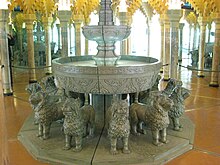Mirror maze
A mirror maze is a special kind of maze .
In contrast to mazes built out of simple board walls, which have a path structure similar to the hedge mazes, in the mirror labyrinth the misleading of the visitor is based almost exclusively on pretended “virtual” routes. The floor plan of these systems, which are always located in closed rooms, is comparatively simple, and their floor space is rather small. Large mirrors, cleverly arranged, simulate endless corridors and at the same time represent barriers that prevent easy passage through the labyrinth . The mirrors are usually at an angle of sixty degrees (or a multiple thereof) to one another and often form a basic grid of equilateral triangles. Columns, implied vaulted ceilings and lamps that appear multiplied like kaleidoscopes increase the illusion of a huge labyrinthine building.
Mirror labyrinths appeared in the 19th century. The prerequisite for their construction was the development of a technology that made it possible to manufacture large, flat mirrors in any number. Leonardo da Vinci had already proposed an octagonal room made up of head-high mirrors, which would have offered those standing in it an infinite reflection of oneself in all directions, but a realization failed due to the lack of sufficiently precise mirrors of sufficient size.
Gustav Castan, originally from Berlin, registered the first patent for a mirror labyrinth in France in 1888. According to his blueprint, the first mirror labyrinth was built in the Sultan's palace in Constantinople in 1889. In 1893 a system followed in Chicago, which was constructed according to the same construction principle. The Petřín Labyrinth in Prague on Petřín Hill has a different, simpler layout. It was created for the Prague jubilee exhibition in 1891 and still exists today.
Mirror labyrinths (selection)
- Petřín Mirror Labyrinth, Czech Republic (1891)
- "Alhambra" in the Lucerne Glacier Garden , Switzerland (1896)
- King Arthur's Mirror Maze, Longleat House , UK (1998)
- Hamburg Dungeon , Germany (2004)
- Aquadom and Sealife Berlin, Germany
- Mirror labyrinth Berlin, Germany (2017)
literature
- Jeff Saward: The origins of mirror and wooden panel mazes. In: Caerdroia. The journal of mazes and labyrinths. No. 37, 2008, pp. 4-12.
- Angelika Friederici: Gustav Castan's mirror labyrinth. In: Castan's Panopticum. A medium is viewed. Issue 25, Berlin 2015, D-10, pp. 12–15.
